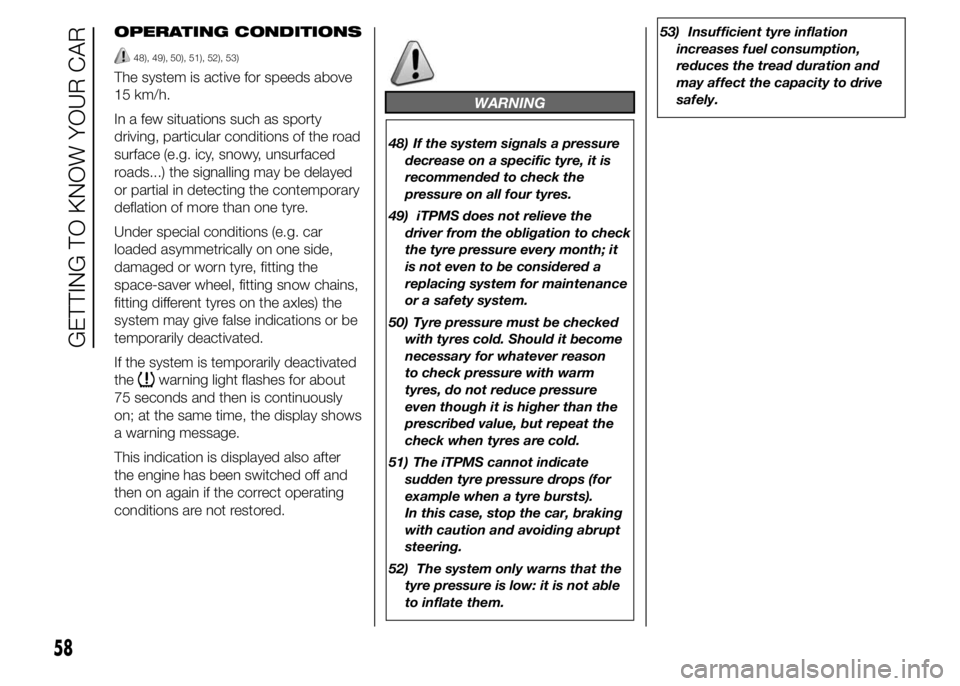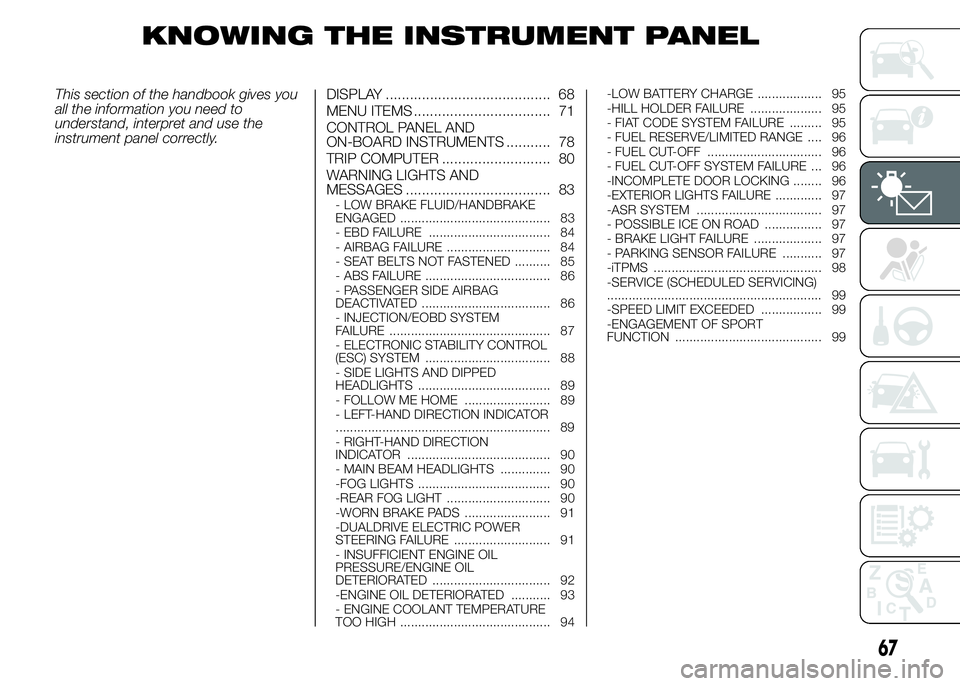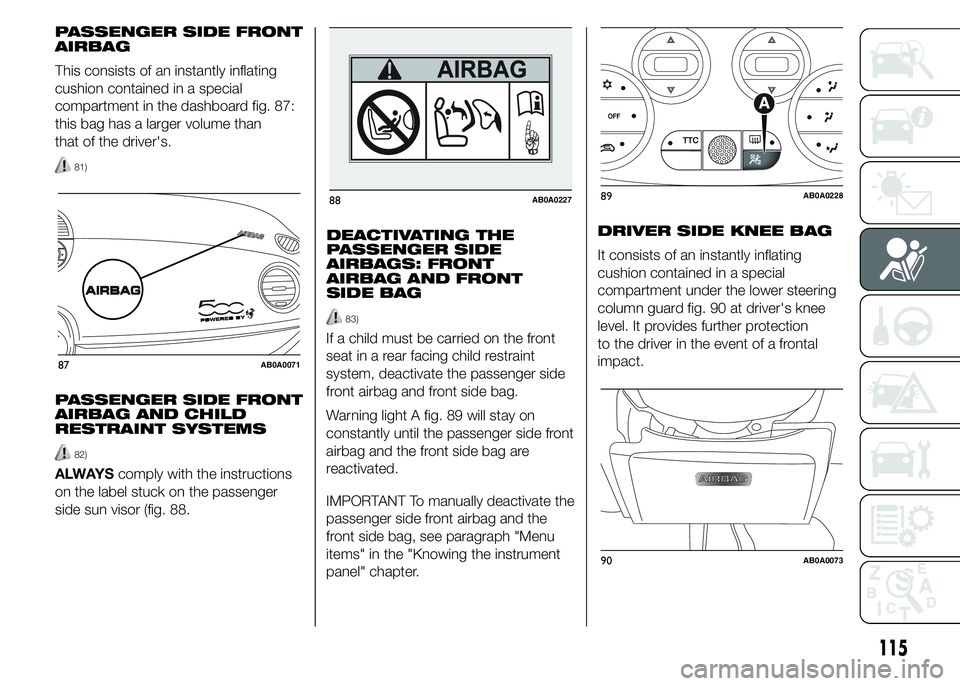steering Abarth 500 2015 Owner handbook (in English)
[x] Cancel search | Manufacturer: ABARTH, Model Year: 2015, Model line: 500, Model: Abarth 500 2015Pages: 215, PDF Size: 19.08 MB
Page 39 of 215

IMPORTANT When the SPORT button
is pressed, the function is activated
about 5 seconds later.
IMPORTANT During acceleration using
the SPORT function the steering may
shudder which is typical of a sports
setting.
HAZARD WARNING
LIGHTS
They are turned on by pressing the
button B fig. 31, regardless of the
position of the ignition key.
With the device on, warning lights
andlight up in the instrument
panel.
Press button B again to switch the
lights off.
IMPORTANT The use of hazard warning
lights is governed by the highway
code of the country you are driving in:
comply with legal requirements.Emergency braking
In the event of an emergency braking,
the hazard warning light switch on
automatically together with warning
lights
andon the instrument
panel.
The lights switch off automatically when
emergency braking ceases.
FRONT FOG
LIGHTS/REAR FOG
LIGHTS
(for versions/markets, where provided)
The fog lights can be activated only
when the dipped headlamps are on.
To turn on the front/rear fog lights, use
the button C fig. 31 as follows:
ŌØÆFirst pressing: front fog lights on;
ŌØÆsecond pressing: rear fog lamps
on;
ŌØÆthird pressing: front/rear fog lights
off.
With front fog lights on, the
warning
light on the instrument panel will come
on at the same time.
With rear fog lights on, the
warning
light on the instrument panel will come
on at the same time.REAR FOG LIGHTS
When the dipped beam headlights are
on, these can be activated by pressing
button
fig. 32.
With lights on, the warning light
on
the instrument panel will come on at the
same time.
Press the button again to switch the
lights off.
FUEL CUT-OFF SYSTEM
This intervenes in the case of an impact
causing:
ŌØÆthe fuel supply cut-off with the engine
consequently switching off
ŌØÆthe automatic unlocking of the doors
ŌØÆturning on the lights inside the
vehicle.
32AB0A0030
35
Page 62 of 215

OPERATING CONDITIONS
48), 49), 50), 51), 52), 53)
The system is active for speeds above
15 km/h.
In a few situations such as sporty
driving, particular conditions of the road
surface (e.g. icy, snowy, unsurfaced
roads...) the signalling may be delayed
or partial in detecting the contemporary
deflation of more than one tyre.
Under special conditions (e.g. car
loaded asymmetrically on one side,
damaged or worn tyre, fitting the
space-saver wheel, fitting snow chains,
fitting different tyres on the axles) the
system may give false indications or be
temporarily deactivated.
If the system is temporarily deactivated
the
warning light flashes for about
75 seconds and then is continuously
on; at the same time, the display shows
a warning message.
This indication is displayed also after
the engine has been switched off and
then on again if the correct operating
conditions are not restored.
WARNING
48) If the system signals a pressure
decrease on a specific tyre, it is
recommended to check the
pressure on all four tyres.
49) iTPMS does not relieve the
driver from the obligation to check
the tyre pressure every month; it
is not even to be considered a
replacing system for maintenance
or a safety system.
50) Tyre pressure must be checked
with tyres cold. Should it become
necessary for whatever reason
to check pressure with warm
tyres, do not reduce pressure
even though it is higher than the
prescribed value, but repeat the
check when tyres are cold.
51) The iTPMS cannot indicate
sudden tyre pressure drops (for
example when a tyre bursts).
In this case, stop the car, braking
with caution and avoiding abrupt
steering.
52) The system only warns that the
tyre pressure is low: it is not able
to inflate them.53) Insufficient tyre inflation
increases fuel consumption,
reduces the tread duration and
may affect the capacity to drive
safely.
58
GETTING TO KNOW YOUR CAR
Page 63 of 215

EOBD SYSTEM
The EOBD (European On Board
Diagnosis system) carries out a
continuous diagnosis of the
components of the car related to
emissions. It also alerts the driver, by
turning on the warning light
on the
instrument panel together with relevant
message on the display, when these
components are no longer in peak
conditions (see chapter "Warning lights
and messages").
The goal of the system is to:
ŌØÆmonitor system efficiency
ŌØÆindicate an increase in emissions due
to vehicle malfunction
ŌØÆindicate the need to replace
damaged components.
The system also has a connector that
can be interfaced with appropriate
equipment, which makes it possible to
read the error codes stored in the
control unit together with a series of
specific parameters for engine
operation and diagnosis.
IMPORTANT After eliminating the
failure, to check the system completely,
Abarth Dealerships must run a bench
test and, if necessary, road tests which
may also call for a long journey.
DUALDRIVE
ELECTRIC POWER
STEERING
(for versions/markets, where provided)
OPERATION
This only operates with the ignition key
turned to MAR-ON and the engine
started.
Electric power steering allows the force
required at the steering wheel to be
adapted to the driving conditions.
IMPORTANT When turning the ignition
key quickly, full power steering
functionality can be achieved after a
few seconds.
When the SPORT function is turned on
(see "Controls" paragraph in this
chapter) the electric power steering
assistance is altered, increasing the
sensitivity of the steering wheel.
54) 55)
IMPORTANT During parking
manoeuvres requiring a lot of steering,
the steering may become harder: this is
normal and is due to the intervention
of the system to protect the electric
steering motor from overheating, so no
repair is required. When the car is
used again later on, the power steering
will work normally.
WARNING
54) It is absolutely forbidden to carry
out any after-market operation
involving steering system or
steering column modifications
(e.g. installation of anti-theft
device) that could adversely affect
performance and safety,
invalidate the warranty and also
result in the car not meeting
type-approval requirements.
55) Before servicing the car, switch
off the engine and remove the key
from the ignition switch to
activate the steering lock. This is
especially important when the car
wheels are not touching the
ground. If this is not possible (for
example if the key needs to be
turned to MAR-ON or the engine
must be running), remove the
main fuse that protects the
electric power steering.
59
Page 71 of 215

KNOWING THE INSTRUMENT PANEL
This section of the handbook gives you
all the information you need to
understand, interpret and use the
instrument panel correctly.DISPLAY ......................................... 68
MENU ITEMS .................................. 71
CONTROL PANEL AND
ON-BOARD INSTRUMENTS ........... 78
TRIP COMPUTER ........................... 80
WARNING LIGHTS AND
MESSAGES .................................... 83
- LOW BRAKE FLUID/HANDBRAKE
ENGAGED .......................................... 83
- EBD FAILURE .................................. 84
- AIRBAG FAILURE ............................. 84
- SEAT BELTS NOT FASTENED .......... 85
- ABS FAILURE ................................... 86
- PASSENGER SIDE AIRBAG
DEACTIVATED .................................... 86
- INJECTION/EOBD SYSTEM
FAILURE ............................................. 87
- ELECTRONIC STABILITY CONTROL
(ESC) SYSTEM ................................... 88
- SIDE LIGHTS AND DIPPED
HEADLIGHTS ..................................... 89
- FOLLOW ME HOME ........................ 89
- LEFT-HAND DIRECTION INDICATOR
............................................................ 89
- RIGHT-HAND DIRECTION
INDICATOR ........................................ 90
- MAIN BEAM HEADLIGHTS .............. 90
-FOG LIGHTS ..................................... 90
-REAR FOG LIGHT ............................. 90
-WORN BRAKE PADS ........................ 91
-DUALDRIVE ELECTRIC POWER
STEERING FAILURE ........................... 91
- INSUFFICIENT ENGINE OIL
PRESSURE/ENGINE OIL
DETERIORATED ................................. 92
-ENGINE OIL DETERIORATED ........... 93
- ENGINE COOLANT TEMPERATURE
TOO HIGH .......................................... 94-LOW BATTERY CHARGE .................. 95
-HILL HOLDER FAILURE .................... 95
- FIAT CODE SYSTEM FAILURE ......... 95
- FUEL RESERVE/LIMITED RANGE .... 96
- FUEL CUT-OFF ................................ 96
- FUEL CUT-OFF SYSTEM FAILURE ... 96
-INCOMPLETE DOOR LOCKING ........ 96
-EXTERIOR LIGHTS FAILURE ............. 97
-ASR SYSTEM ................................... 97
- POSSIBLE ICE ON ROAD ................ 97
- BRAKE LIGHT FAILURE ................... 97
- PARKING SENSOR FAILURE ........... 97
-iTPMS ............................................... 98
-SERVICE (SCHEDULED SERVICING)
............................................................ 99
-SPEED LIMIT EXCEEDED ................. 99
-ENGAGEMENT OF SPORT
FUNCTION ......................................... 99
67
Page 95 of 215

Warning lights on
panelWhat it means What to do
amberWORN BRAKE PADS
(for versions/markets, where provided)
The warning light on the display switches on
when the front or rear brake pads are worn.
The display shows the dedicated message.Have them replaced as soon as possible.
redDUALDRIVE ELECTRIC POWER STEERING
FAILURE
The warning light switches on when the ignition
key is turned to MAR-ON, but it should switch off
after a few seconds.
If the warning light stays on, you will not benefit
from the electric power steering and the effort
needed to turn the wheel will be significantly
increased, although it will still be possible to steer
the car.If the warning light stays on, contact an Abarth
Dealership as soon as possible.
91
Page 102 of 215

Warning lights on
displayWhat it means What to do
amberiTPMS
(for versions/markets, where provided)
When the key is turned to MAR-ON, the warning
light switches on but it should switch off after a
few seconds.IMPORTANT Do not continue driving with one or
more flat tyres as handling may be compromised.
Stop the vehicle, avoiding sharp braking and
steering.
Low tyre pressure
The warning light switches to indicate that the
pressure of one or more tyres is lower than the
recommended value, in order to guarantee long
tyre life and low fuel consumption, or to indicate a
slow loss of pressure.
In this way the iTPMS warns the driver that one or
more tyres may be flat and probably punctured.In this case it is advisable to restore the correct
pressure value (see the "Wheels" paragraph in the
"Technical specifications" section).
Once the normal operating conditions of the
vehicle are restored, carry out the Reset
procedure.
iTPMS failure/iTPMS temporarily deactivated
The warning light flashes for about 75 seconds
and then stays on constantly (together with a
message on the display) (see ŌĆ£Operating
conditionsŌĆØ paragraph) to indicate that the system
is temporarily deactivated or faulty.
The system goes back to normal operation when
the operating conditions allow it. If this is not the
case, carry out the Reset procedure after
restoring the normal operating conditions.If the malfunction warning persists, contact an
Abarth Dealership as soon as possible.
98
KNOWING THE INSTRUMENT PANEL
Page 118 of 215

FRONT AIRBAGS
The front driver/passenger airbags and
the driver's knee bag (for versions/
markets, where provided) protect the
front seat occupants in the event of
frontal impacts of medium/high severity,
by placing the bag between the
occupant and the steering wheel or
dashboard.
Therefore non-activation in other types
of collisions (side impacts, rear shunts,
roll-overs, etc.) does not indicate a
system malfunction.
An electronic control unit will make the
bag inflate in the event of a frontal
impact.
The bag will inflate instantaneously
placing itself between the front
occupants body and the structures
which could cause injury. It will deflate
immediately afterwards.
Front airbags are not a replacement of
but complementary to the seat belts,
which you are recommended to always
wear, as specified by law in Europe
and most non-European countries.In the event of an impact, someone not
wearing a seat belt will move forward
and come into contact with the bag
which is still in the opening stage. The
protection offered by the bag is
compromised in these circumstances.
Front airbags may not be activated
in the following situations:
ŌØÆfrontal impacts against highly
deformable objects not involving the
front surface of the car (e.g. wing
collision against guard rail);
ŌØÆjamming of the car underneath other
vehicles or protective barriers (e.g.
underneath a truck or a guard rail)
since the bags would offer no
additional protection with respect to
the seat belt and their deployment
would be inappropriate. In these
cases, non-deployment does not
indicate a system malfunction.
80)
The front airbags (driver, passenger,
driver's knee bags) are designed and
calibrated to protect front seat
passengers wearing seat belts.Their volume at the moment of
maximum inflation fills most of the
space between the steering wheel and
the driver, between the lower steering
column guard and the knees on driver
side and between the dashboard and
the passenger.
The airbags are not deployed in the
event of minor frontal impacts (for
which the restraining action of the seat
belts is sufficient). Seat belts must
always be worn. In the event of frontal
impacts they guarantee correct
positioning of the passenger.
DRIVER'S SIDE FRONT
AIRBAG
This consists of an instantly inflating
cushion contained in a special
compartment in the centre of the
steering wheel fig. 86.
86AB0A0070
114
SAFETY
Page 119 of 215

PASSENGER SIDE FRONT
AIRBAG
This consists of an instantly inflating
cushion contained in a special
compartment in the dashboard fig. 87:
this bag has a larger volume than
that of the driver's.
81)
PASSENGER SIDE FRONT
AIRBAG AND CHILD
RESTRAINT SYSTEMS
82)
ALWAYScomply with the instructions
on the label stuck on the passenger
side sun visor (fig. 88.DEACTIVATING THE
PASSENGER SIDE
AIRBAGS: FRONT
AIRBAG AND FRONT
SIDE BAG
83)
If a child must be carried on the front
seat in a rear facing child restraint
system, deactivate the passenger side
front airbag and front side bag.
Warning light A fig. 89 will stay on
constantly until the passenger side front
airbag and the front side bag are
reactivated.
IMPORTANT To manually deactivate the
passenger side front airbag and the
front side bag, see paragraph "Menu
items" in the "Knowing the instrument
panel" chapter.DRIVER SIDE KNEE BAG
It consists of an instantly inflating
cushion contained in a special
compartment under the lower steering
column guard fig. 90 at driver's knee
level. It provides further protection
to the driver in the event of a frontal
impact.
87AB0A0071
88AB0A022789AB0A0228
90AB0A0073
115
Page 121 of 215

WARNING
80) Do not apply stickers or other objects on the steering wheel, on the dashboard in the passenger side airbag area, on
the side cover on the roof and on the seats. Never put objects (e.g. mobile phones) on the passenger's side
dashboard since they could interfere with correct inflation of the airbag and also cause serious injury to the
passengers.
81) SEVERE DANGER: when an active passenger airbag is fitted, DO NOT install rear facing child restraint systems on
the front seat. Deployment of the airbag in an accident could cause fatal injuries to the child regardless of the
severity of the impact. Therefore, always deactivate the passenger side airbag when a rear facing child restraint
system is installed on the front passenger seat. The front passenger seat must also be positioned back as far
as possible in order to prevent the child restraint system from coming into contact with the dashboard. Immediately
reactivate the passenger airbag as soon as the child restraint system has been removed.
82) When an active passenger airbag is fitted, DO NOT install rear facing child restraint systems on the front seat.
Deployment of the airbag in an accident could cause fatal injuries to the child regardless of the severity of the
impact.
83) Warning light
indicates fault of warning light. This condition is indicated by intermittent blinking of warning
light
for longer than 4 seconds. In this case, thewarning light may not indicate a fault in the restraint systems.
Before driving off, contact an Abarth Dealership to have the system checked immediately.
117
Page 124 of 215

88) Always drive keeping your hands
on the steering wheel rim so that
the airbag can inflate freely if
necessary. Do not drive with your
body bent forward. Keep your
back straight against the
backrest.
89) If the car has been subject to
theft, attempted theft, vandalism,
or flooding, have the airbag
system inspected at an Abarth
Dealership.90) Airbags may be deployed if
another vehicle crashes into the
car, if the key is inserted and
at MAR-ON even if the engine is
not running and the car is
stationary. Therefore, even if the
car is stationary, when an active
front passenger airbag is fitted,
DO NOT install rear facing child
restraint systems on the front
passenger seat. Deployment of
the airbag following an impact
could cause fatal injuries to the
child. Therefore, always
deactivate the passenger airbag
when a rear facing child restraint
system is installed on the front
passenger seat. The front
passenger seat must also be
positioned back as far as possible
in order to prevent the child
restraint system from coming into
contact with the dashboard.
Immediately reactivate the
passenger airbag as soon as the
child restraint system has been
removed. Also remember that,
if the key is turned to STOP, none
of the safety devices (airbags or
pretensioners) will be deployed in
the event of collision. Non-
deployment in such cases does
not indicate a system malfunction.91) When the ignition key is turned
to MAR-ON, the
warning light
turns on and flashes for a few
seconds to remind you that the
passenger's airbag will be
deployed in a crash, after which it
should switch off.
92) Do not wash the seats with
water or pressurised steam (wash
by hand or at automatic car seat
washing stations).
93) The front airbag deployment
threshold is higher than that of
the pretensioners. For collisions in
the range between the two
thresholds, it is normal for only
the pretensioners to be activated.
94) Do not affix rigid objects to the
coat hooks or support handles.
95) The airbag does not replace seat
belts but increases their
effectiveness. Furthermore, since
front airbags are not deployed
in low-speed frontal impacts, side
impacts, rear shunts or roll-overs,
the passengers are protected
only by the seat belts which must
therefore be fastened at all times.
120
SAFETY